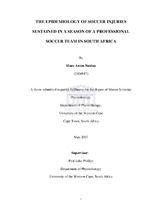| dc.description.abstract | Literature has described soccer as the most popular sporting code in the world. South Africa heralds a registry of 1.8 million players. The purpose of the study was to conduct a detailed analysis of soccer injuries sustained in South African professional soccer team over one competitive season. The study utilized a questionnaire to collect quantitative data assessing age of players injures, playing position, site of injury, mechanism of injury, injury management, physiotherapy access and prevention measures which was administered by a physiotherapist at competitive matches. The study defined injury as any injury sustained during competitive matches where a player received medical attention. The study sample consisted of 26 male soccer players ranging from 17-39 years with a mean age of 23.77 years (SD=5.233). Injury prevalence was reported as 58% with a significance (p<0.05) in the ages of players injured compared to the non-injured. The majority of injuries were sustained by the 20-24 year old players coupled with midfielders being the most predominant position encountering injury (40%). The lower limbs were the most affected (67.1%) with the knee being reported as the most affected joint (21.4%). Defenders and midfielders were significantly more likely to sustain a lower limb injury compared to goalkeepers and forwards who were seen to incur more trunk injuries. The majority of injuries were the result of being tackled (27.2%). A significance was reported with mechanism of injury and playing position (Fisher’s Exact=41.118, p<0.05). Injurymanagement was predominantly self treatment followed by physiotherapy treatment (30%). The main contributor to the decrease in physiotherapy treatment received by players the absence of the service at the club (65.7%) and financial reasons (54.3%). The results of the study confirm that many SouthAfrican professional soccer players are prey to sustaining injury during one competitive soccer season. The study highlighted the need to start prevention efforts at club level in order to curtail the high injury prevalence at professional levels. | en_US |

